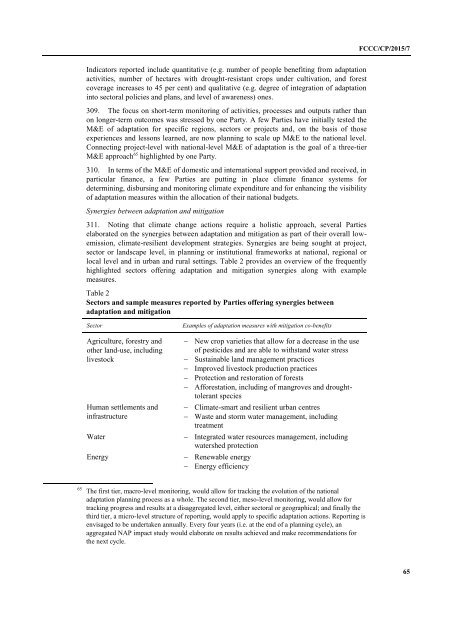FCCC/CP/2015/7
1PYuHQM
1PYuHQM
Create successful ePaper yourself
Turn your PDF publications into a flip-book with our unique Google optimized e-Paper software.
<strong>FCCC</strong>/<strong>CP</strong>/<strong>2015</strong>/7<br />
Indicators reported include quantitative (e.g. number of people benefiting from adaptation<br />
activities, number of hectares with drought-resistant crops under cultivation, and forest<br />
coverage increases to 45 per cent) and qualitative (e.g. degree of integration of adaptation<br />
into sectoral policies and plans, and level of awareness) ones.<br />
309. The focus on short-term monitoring of activities, processes and outputs rather than<br />
on longer-term outcomes was stressed by one Party. A few Parties have initially tested the<br />
M&E of adaptation for specific regions, sectors or projects and, on the basis of those<br />
experiences and lessons learned, are now planning to scale up M&E to the national level.<br />
Connecting project-level with national-level M&E of adaptation is the goal of a three-tier<br />
M&E approach 65 highlighted by one Party.<br />
310. In terms of the M&E of domestic and international support provided and received, in<br />
particular finance, a few Parties are putting in place climate finance systems for<br />
determining, disbursing and monitoring climate expenditure and for enhancing the visibility<br />
of adaptation measures within the allocation of their national budgets.<br />
Synergies between adaptation and mitigation<br />
311. Noting that climate change actions require a holistic approach, several Parties<br />
elaborated on the synergies between adaptation and mitigation as part of their overall lowemission,<br />
climate-resilient development strategies. Synergies are being sought at project,<br />
sector or landscape level, in planning or institutional frameworks at national, regional or<br />
local level and in urban and rural settings. Table 2 provides an overview of the frequently<br />
highlighted sectors offering adaptation and mitigation synergies along with example<br />
measures.<br />
Table 2<br />
Sectors and sample measures reported by Parties offering synergies between<br />
adaptation and mitigation<br />
Sector<br />
Agriculture, forestry and<br />
other land-use, including<br />
livestock<br />
Human settlements and<br />
infrastructure<br />
Water<br />
Energy<br />
Examples of adaptation measures with mitigation co-benefits<br />
New crop varieties that allow for a decrease in the use<br />
of pesticides and are able to withstand water stress<br />
Sustainable land management practices<br />
Improved livestock production practices<br />
Protection and restoration of forests<br />
Afforestation, including of mangroves and droughttolerant<br />
species<br />
Climate-smart and resilient urban centres<br />
Waste and storm water management, including<br />
treatment<br />
Integrated water resources management, including<br />
watershed protection<br />
Renewable energy<br />
Energy efficiency<br />
65 The first tier, macro-level monitoring, would allow for tracking the evolution of the national<br />
adaptation planning process as a whole. The second tier, meso-level monitoring, would allow for<br />
tracking progress and results at a disaggregated level, either sectoral or geographical; and finally the<br />
third tier, a micro-level structure of reporting, would apply to specific adaptation actions. Reporting is<br />
envisaged to be undertaken annually. Every four years (i.e. at the end of a planning cycle), an<br />
aggregated NAP impact study would elaborate on results achieved and make recommendations for<br />
the next cycle.<br />
65


